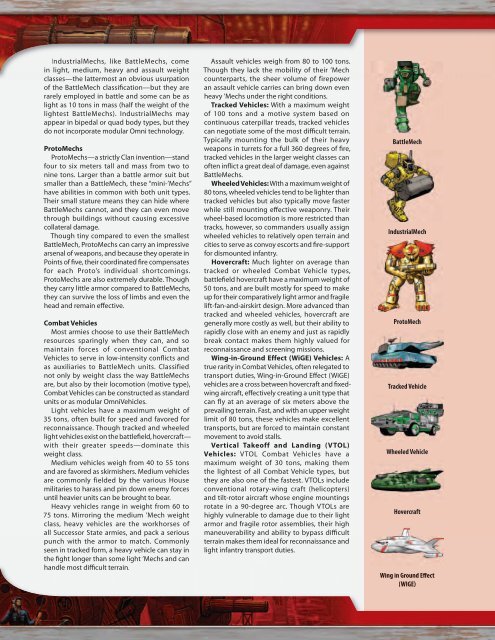the shape of things to come
the shape of things to come
the shape of things to come
You also want an ePaper? Increase the reach of your titles
YUMPU automatically turns print PDFs into web optimized ePapers that Google loves.
IndustrialMechs, like BattleMechs, <strong>come</strong><br />
in light, medium, heavy and assault weight<br />
classes—<strong>the</strong> lattermost an obvious usurpation<br />
<strong>of</strong> <strong>the</strong> BattleMech classifi cation—but <strong>the</strong>y are<br />
rarely employed in battle and some can be as<br />
light as 10 <strong>to</strong>ns in mass (half <strong>the</strong> weight <strong>of</strong> <strong>the</strong><br />
lightest BattleMechs). IndustrialMechs may<br />
appear in bipedal or quad body types, but <strong>the</strong>y<br />
do not incorporate modular Omni technology.<br />
Pro<strong>to</strong>Mechs<br />
Pro<strong>to</strong>Mechs—a strictly Clan invention—stand<br />
four <strong>to</strong> six meters tall and mass from two <strong>to</strong><br />
nine <strong>to</strong>ns. Larger than a battle armor suit but<br />
smaller than a BattleMech, <strong>the</strong>se “mini-’Mechs”<br />
have abilities in common with both unit types.<br />
Their small stature means <strong>the</strong>y can hide where<br />
BattleMechs cannot, and <strong>the</strong>y can even move<br />
through buildings without causing excessive<br />
collateral damage.<br />
Though tiny compared <strong>to</strong> even <strong>the</strong> smallest<br />
BattleMech, Pro<strong>to</strong>Mechs can carry an impressive<br />
arsenal <strong>of</strong> weapons, and because <strong>the</strong>y operate in<br />
Points <strong>of</strong> fi ve, <strong>the</strong>ir coordinated fi re compensates<br />
for each Pro<strong>to</strong>’s individual shortcomings.<br />
Pro<strong>to</strong>Mechs are also extremely durable. Though<br />
<strong>the</strong>y carry little armor compared <strong>to</strong> BattleMechs,<br />
<strong>the</strong>y can survive <strong>the</strong> loss <strong>of</strong> limbs and even <strong>the</strong><br />
head and remain eff ective.<br />
Combat Vehicles<br />
Most armies choose <strong>to</strong> use <strong>the</strong>ir BattleMech<br />
resources sparingly when <strong>the</strong>y can, and so<br />
maintain forces <strong>of</strong> conventional Combat<br />
Vehicles <strong>to</strong> serve in low-intensity confl icts and<br />
as auxiliaries <strong>to</strong> BattleMech units. Classified<br />
not only by weight class <strong>the</strong> way BattleMechs<br />
are, but also by <strong>the</strong>ir locomotion (motive type),<br />
Combat Vehicles can be constructed as standard<br />
units or as modular OmniVehicles.<br />
Light vehicles have a maximum weight <strong>of</strong><br />
35 <strong>to</strong>ns, <strong>of</strong>ten built for speed and favored for<br />
reconnaissance. Though tracked and wheeled<br />
light vehicles exist on <strong>the</strong> battlefi eld, hovercraft—<br />
with <strong>the</strong>ir greater speeds—dominate this<br />
weight class.<br />
Medium vehicles weigh from 40 <strong>to</strong> 55 <strong>to</strong>ns<br />
and are favored as skirmishers. Medium vehicles<br />
are commonly fielded by <strong>the</strong> various House<br />
militaries <strong>to</strong> harass and pin down enemy forces<br />
until heavier units can be brought <strong>to</strong> bear.<br />
Heavy vehicles range in weight from 60 <strong>to</strong><br />
75 <strong>to</strong>ns. Mirroring <strong>the</strong> medium ’Mech weight<br />
class, heavy vehicles are <strong>the</strong> workhorses <strong>of</strong><br />
all Successor State armies, and pack a serious<br />
punch with <strong>the</strong> armor <strong>to</strong> match. Commonly<br />
seen in tracked form, a heavy vehicle can stay in<br />
<strong>the</strong> fi ght longer than some light ’Mechs and can<br />
handle most diffi cult terrain.<br />
Assault vehicles weigh from 80 <strong>to</strong> 100 <strong>to</strong>ns.<br />
Though <strong>the</strong>y lack <strong>the</strong> mobility <strong>of</strong> <strong>the</strong>ir ’Mech<br />
counterparts, <strong>the</strong> sheer volume <strong>of</strong> firepower<br />
an assault vehicle carries can bring down even<br />
heavy ’Mechs under <strong>the</strong> right conditions.<br />
Tracked Vehicles: With a maximum weight<br />
<strong>of</strong> 100 <strong>to</strong>ns and a motive system based on<br />
continuous caterpillar treads, tracked vehicles<br />
can negotiate some <strong>of</strong> <strong>the</strong> most diffi cult terrain.<br />
Typically mounting <strong>the</strong> bulk <strong>of</strong> <strong>the</strong>ir heavy<br />
weapons in turrets for a full 360 degrees <strong>of</strong> fi re,<br />
tracked vehicles in <strong>the</strong> larger weight classes can<br />
<strong>of</strong>ten infl ict a great deal <strong>of</strong> damage, even against<br />
BattleMechs.<br />
Wheeled Vehicles: With a maximum weight <strong>of</strong><br />
80 <strong>to</strong>ns, wheeled vehicles tend <strong>to</strong> be lighter than<br />
tracked vehicles but also typically move faster<br />
while still mounting eff ective weaponry. Their<br />
wheel-based locomotion is more restricted than<br />
tracks, however, so commanders usually assign<br />
wheeled vehicles <strong>to</strong> relatively open terrain and<br />
cities <strong>to</strong> serve as convoy escorts and fi re-support<br />
for dismounted infantry.<br />
Hovercraft: Much lighter on average than<br />
tracked or wheeled Combat Vehicle types,<br />
battlefi eld hovercraft have a maximum weight <strong>of</strong><br />
50 <strong>to</strong>ns, and are built mostly for speed <strong>to</strong> make<br />
up for <strong>the</strong>ir comparatively light armor and fragile<br />
lift-fan-and-airskirt design. More advanced than<br />
tracked and wheeled vehicles, hovercraft are<br />
generally more costly as well, but <strong>the</strong>ir ability <strong>to</strong><br />
rapidly close with an enemy and just as rapidly<br />
break contact makes <strong>the</strong>m highly valued for<br />
reconnaissance and screening missions.<br />
Wing-in-Ground Effect (WiGE) Vehicles: A<br />
true rarity in Combat Vehicles, <strong>of</strong>ten relegated <strong>to</strong><br />
transport duties, Wing-in-Ground Eff ect (WiGE)<br />
vehicles are a cross between hovercraft and fi xedwing<br />
aircraft, eff ectively creating a unit type that<br />
can fly at an average <strong>of</strong> six meters above <strong>the</strong><br />
prevailing terrain. Fast, and with an upper weight<br />
limit <strong>of</strong> 80 <strong>to</strong>ns, <strong>the</strong>se vehicles make excellent<br />
transports, but are forced <strong>to</strong> maintain constant<br />
movement <strong>to</strong> avoid stalls.<br />
Vertical Take<strong>of</strong>f and Landing (VTOL)<br />
Vehicles: VTOL Combat Vehicles have a<br />
maximum weight <strong>of</strong> 30 <strong>to</strong>ns, making <strong>the</strong>m<br />
<strong>the</strong> lightest <strong>of</strong> all Combat Vehicle types, but<br />
<strong>the</strong>y are also one <strong>of</strong> <strong>the</strong> fastest. VTOLs include<br />
conventional rotary-wing craft (helicopters)<br />
and tilt-ro<strong>to</strong>r aircraft whose engine mountings<br />
rotate in a 90-degree arc. Though VTOLs are<br />
highly vulnerable <strong>to</strong> damage due <strong>to</strong> <strong>the</strong>ir light<br />
armor and fragile ro<strong>to</strong>r assemblies, <strong>the</strong>ir high<br />
maneuverability and ability <strong>to</strong> bypass diffi cult<br />
terrain makes <strong>the</strong>m ideal for reconnaissance and<br />
light infantry transport duties.<br />
BattleMech<br />
IndustrialMech<br />
Pro<strong>to</strong>Mech<br />
Tracked Vehicle<br />
Wheeled Vehicle<br />
Hovercraft<br />
Wing in Ground Eff ect<br />
(WIGE)


